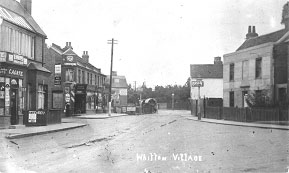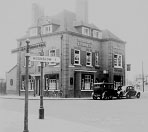Whitton - Then and Now
Development in the 1930s changes the face of Whitton

Until about 1800 Whitton was a hamlet centred on the crossroads where the present Nelson and Kneller Roads and Whitton Dene meet. At the time an increasing amount of the open land around Whitton was becoming common or enclosed market gardens, nurseries and orchards. Hounslow Heath was enclosed by the Act of 1818 and new roads were laid out across the old heath. This extended the boundaries of Whitton, doubling the previous area.

In 1862 Whitton which had always been part of the parish of St Mary's, Twickenham, became a separate parish and the church of St Philip and St James was built. In 1857, The Royal Military School of Music opened at Kneller Hall in the third house to occupy the site. By the 1871 Census there were 144 soldiers and student soldiers in training, half of these being 16 years of age or younger.

A Local Board for Twickenham, including Whitton, was formed in 1868, becoming an Urban District Council in 1895. Market gardening in Twickenham and Whitton reached a peak in the 1870s. The area at that time was later recalled as “The road to Whitton and Kneller Hall then lay between fields and agriculture of all kinds”.

There was a modest building boom in the first decade of the 20th century and two small parades of shops were built in 1906-7 in Nelson Road and Hounslow Road to serve the increased population. However, expansion was restricted because transport links were poor. Improvement started with the compulsory purchase of Chase Bridge in 1928 and the first omnibus route linking Twickenham with Hounslow was then introduced. Next, in 1930, Whitton railway station opened and in 1933 the Great Chertsey Road was built as far as Hospital Bridge Road.

Between 1930 and 1939 the village was transformed out of all recognition. Part of Percy Road, then a country lane, became a new High Street running between the Nelson public house and the railway. The first shops opened in late 1931 and by 1939 there were 96 businesses in operation.




